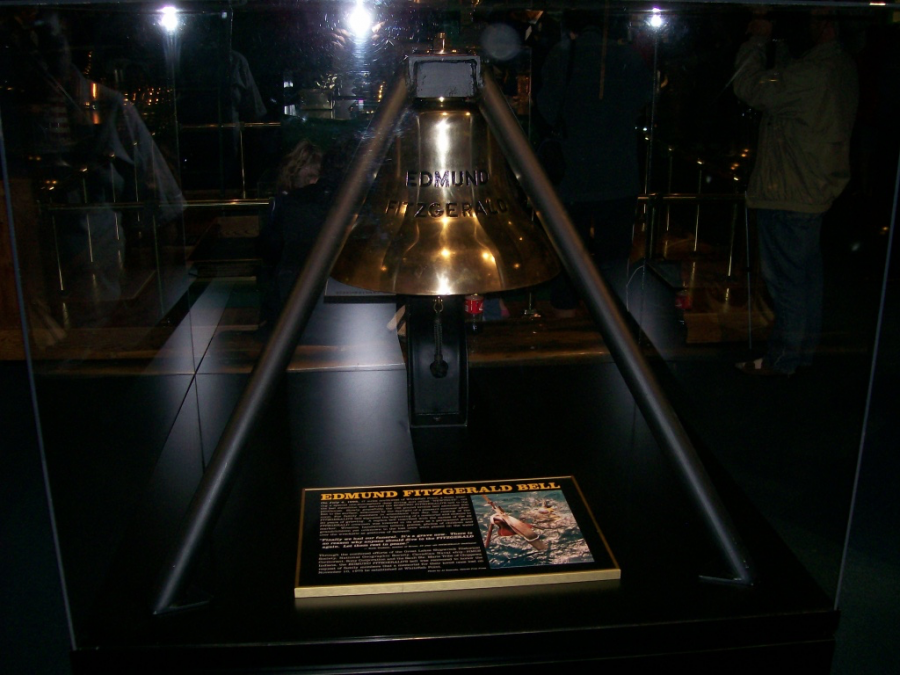The Tragedy Of The Edmund Fitzgerald
The recovered bell from the wreck of the Edmund Fitzgerald, taken by Mr. Beck.
October 5, 2018
On November 10, 1975, the great freighter Edmund Fitzgerald capsized and sank to the depths of Lake Superior, caught in a deadly storm.
November is a tough season on the Great Lakes, with deadly, hurricane force winds that batter even the toughest freighter. Loaded with 26,116 tons of iron ore pellets, the Fitzgerald left Superior, Wisconsin at 2:30 pm. With the Arthur M. Anderson 10-15 miles behind it, the Fitzgerald left, with radio contact with the Anderson until 7 pm on November 10. A storm warning was issued on the morning of the 10th, and giant waves reached 35 feet, with winds close to 100 mph.
“I was a student at Central Michigan University. I had been going to Lake Superior University. A lot of my friends were still there,” Ms. Howe, a counselor at West Middle School, tells Bite reporter Josie Fillman. “They said the storm was very bad.”
Coast Guard officials at Sault Ste. Marie had been contacted and informed that the Fitz was taking on water, but otherwise, they heard nothing. Soon after, a blizzard had obscured the Fitz on the Andersons radar. The captain of the Fitz assured the Anderson that they were holding their own, but the Anderson didn’t hear anything else from the Fitzgerald.
In 1957, Great Lakes Engineering Works of Escourse, Michigan, was hired to build this freighter by Northwestern Mutual Insurance Company, who invested in iron and material industries. It was decided that the ship would be named after Northwestern Mutual’s owner, Edmund Fitzgerald. After the great freighter was finished, it was the biggest ship on the Great Lakes, being 729 feet long, sat 39 feet high, had a width of 75 feet, and weighed over 13,000 tons without any cargo. The Edmund Fitzgerald was christened on June 8, 1958, and set out for her first voyage on September 24, the same year. Year after year, the Fitz became famous, gaining nicknames such as “The Queen of the Great Lakes,”, “The Toledo Express,” and unfortunately and ironically, “The Titanic of the Great Lakes.” Crowds would watch her as she moved through Sault Ste. Marie in the Upper Peninsula. The ‘Soo’ locks connect Lake Huron to Lake Superior and allowed the Fitz to pass onto ports at the lower Great Lakes. Everything was going great, until that tragic night.
Not even a year after the sinking, the US Coast Guard and Navy planes and cutters located the wreckage of the Fitz, 525 feet below the lake’s surface. Very few people have been able to see the wreck, which sits on the bottom in two pieces.
In 1995, a group consisting of the Canadian Navy, the National Geographic Society, Sony, and the Sault Ste. Marie Tribe of Chippewa Indians recovered the ships bell. This act was on behalf of the families who lost someone there. But, the Canadian government closed access to the wreckage. Ever since, the annual Edmund Fitzgerald memorial anniversary takes place on its sinking day, at the Great Lakes Shipwreck Museum at Whitefish Point. The restored bell rings 29 times for each crew member who died and the last time for the around 30,000 mariners who perished on the waves of the Lakes.

Dillon Starnes • Oct 22, 2018 at 12:20 pm
This article is very good.
Caitlin • Oct 10, 2018 at 12:08 pm
Great job with your article Josie! It looks amazing.